The Tiger class were three and last light conventional cruisers built for the Royal Navy. They were initially known as the Minotaur-class cruisers (Blake, Defence and Bellerophon) and started in late WW2 but shelved due to post-war austerity. Amidst changing priorities and still under financial limits, it was eventually decided to resume their construction but on modified design according to the latest evolutions on November 1954. New named were Tiger, Lion and Blake, which entered service from March 1959. In January 1964 another change in ppolicy had them reconverted as helicopter-carrying cruisers, first with four Westland Wessex helicopters both for amphibious warfare and ASW escort and then four Westland Sea Kings but conversion costs skyrocketed. Only Blake and Tiger, went through it between 1965 and 1972, but Lion’s was cancelled. She was scrapped a few years later in 1975, and cannibalized for her sisters. Some in the press an even in the admiralty called them
ugly useless duckings and due to better ships with smaller crews being available, they were were decommissioned in the late 1970s, the first scrapped in 1982 and Tiger in 1986.
Development
Initial design
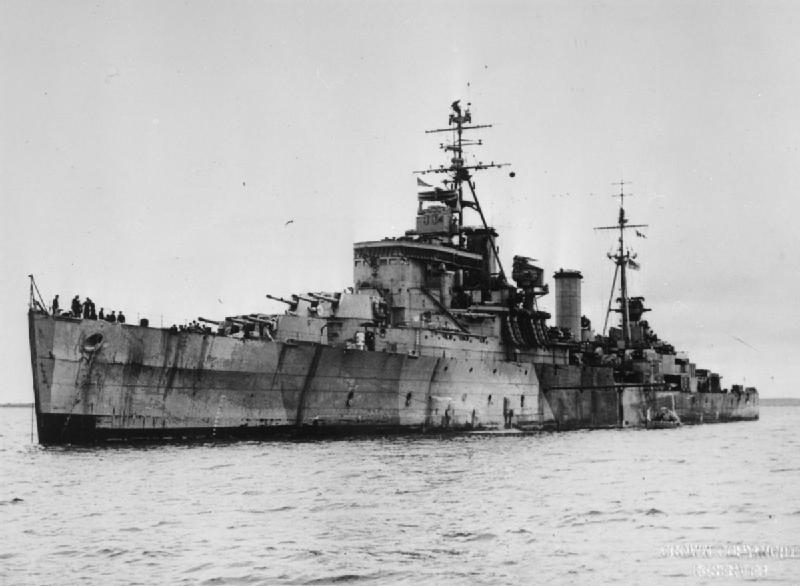
The Minotaur class initially counted eight ships. The class was split up, two of the first batch and three of the second were even completed.
The future Tiger class was first known as the Minotaur class, and they were initially ordered as “improved Fiji” class cruisers. The latter were also known as the “crown colony” and an evolution of the previous 1936 “Town” class cruisers, a post London treaty design with nearly 10,000t and twelve 6-in light guns. The latter were seen as a good compromise on the Fiji, being capable of AA fire. The Fiji were essentially a wartime, wheaper version of the Town, and in time received a good Bofors armament. They did well and motivated two more classes, the Swiftsure (launched 1943). It was decided after Pearl Harbor to built eight 64-foot broad beam both modified and improved cruisers, larger for a long range and more AA and better tailored to face the IJN.
When British Malaya was invaded, this made the new design even more urgent. They were “booked” in the 1941 supplementary shipbuilding programme and 1942 estimates (April 1942) and to start with something, were essentially improved models of the Ceylon or Uganda sub-group of the Fiji-class. HMS Defence, Bellerophon, Blake and Hawke were started as Minotaur-class cruisers with three triple 6-inch gun turrets in 1944. But suddently the 1942 Design Light Fleet Carriers program received more support and was given priority from August 1942, whene examined by the Building Committee. By August 1942, four more unnamed Minotaur cruisers were cancelled. What have been done already, machinery equipments, artillery were just stored or recycled into the Colossus class.
On this list, HMS Bellerophon became HMS Tiger in 1945 and eventually ordered in May 1941, her keel laid down at Browns Clydebank yard whereas Swiftsure and Minotaur were ordered by October 1941. Blake was started at Fairfields in August 1942 but her and Tiger’s construction was slowed down. Hawke was not even laid down until July 1943, and the eighth one was never ordered and later cancelled. Priorities contnued to pile up. The Minotaur class class was further hit when the large fleet carrier HMS Africa (Malta-class) from Fairfield effectively suspended work on Bellerophon and Blake from March 1944 to July 1945. The war ended well before the new “pacific carriers” could be ready. Not only these cruisers received the lowest priority, further delays came from industrial disputes, labor shortages and strikes, as well as sub-standard facilities with wprn out equipments and even lower quality steel being delivered, notably at Scotts and Greenock.
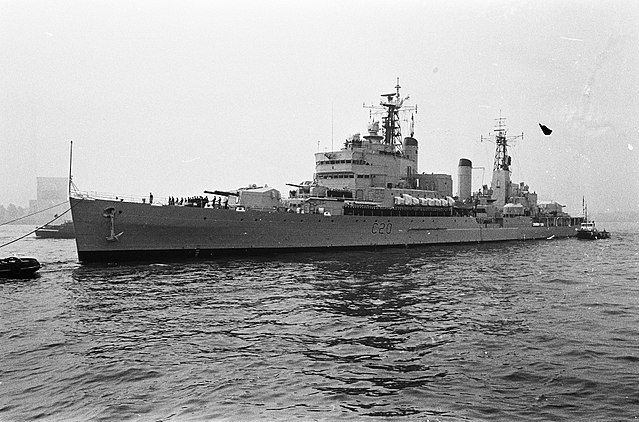
HMS Tiger in Rotterdam
Concerns by these delay of what was now the “Tiger-class” led the Director of Naval Construction (DNC) visiting Scotts yard in August 1943. He was greeted by striking riveters, carpenters and shipwrights and an announcement by the direction of a launch of Defence by April 1944, completion in July 1945 at best, Hawke commission mid-1945, Blake and Tiger commissioning mid-1946. Minotaur, Swiftsure and Superb were the only one of this late 1941 program eventually completed by late 1945, seeing limited wartime action. HMS Defence on V-Day saw all work stopped after launch, and she was placed in reserve, without armament. She would be mothballed in that stae for eight years, offshore in Gareloch. In fact none of these cruisers will be completed in their “WW2 outfit”. It was now seen wise by the admiralty, having already plenty of cruisers to evaluate those to be axed (decommissioned) and those kept for more years. Eventually, the whole County class, now 20 years old and worn out, were the first to go alongside the surviving Leander/Arethusa light cruisers and half the Town class. Some of the Fiji were resold aboard, as the Dido/Bellona.
Wartime design revisions
In January 1943 it was decided to increase the beam of Bellerophon to 64 ft (20 m) and by March as the Tiger class were still in early pre-launch construction, it was decided to upgrade their main armament. The Mk XXIII (or Mark 23) triple 6-inch turret in dual purpose electrically-powered Mark 24 mounts were ordered for five cruisers, Blake, Hawke, Tiger, Defence and Bellerophon. These were capable of 60° elevation, way better than on the Fiji while having better loading speed and guidance. HMS Minotaur, Swiftsure and Superb, the most advanced received indeed their nine Mk 23 turrets.
By late 1943 however priorities started to shift. The axis was practically defeated, Italy surrendered in Septelmber while the remainder of the Kriegsmarine was in tatters, focusing on U-Boats. Pluys the US were now at war and brough to the fight more than a hundred cruisers, light and heavy. The cruiser requirement dropped to the bottom of the pile. The the light fleet carriers and new Battle-class destroyers however were prioritized and by 1944-45 starved manpower from other projects, cruisers first. The latter were made an absolute priority for Churchill in October–December 1943 and Britain had at that stage more cruisers refitting or completing than crews available. Extra Bellona class (5.25-inch AA cruisers) were axed as well as five more 7,000 ton of the same and N2 class all were cancelled by February 1944. The Tiger class even competed with the large Neptune-class heavy cruisers placced for the Pacific and replace the old County, armed with the same Mk 24 turrets with a second battery similar to the Daring-class destroyers. They too, were delayed. Two of the new Swiftsure class went to the RCN in April 1944 and June 1945. So juts one of the Minotaur class remained.
Both in 1944 and again by February 1945 it was proposed to push the completion of two light aircraft for the Royal Australian Navy albeit to escort them the Govermnemt offering HMS Defence and Blake as escorts, but it was not accepted. Australia also had a manpower problem, unresomved by mid-1945. With such as massive naval superiority the RAN preferred to prolongate and modernize its own two County-class heavy cruisers until 1950-54.
In 1944–45, the RN as well as the CNS and the government discussed about merging the cruiser and destroyer role but this only delayed decision about the last cruisers being built. The Neptune class was cancelled as much faith was placed in the sucessors of the Battle and Daring class DDs. As for the only three advanced cruiser hulls available it was now clear they needed rearmament. In 1946, their nine planned Mk 24 turrets were 75–80% complete, three further turrets partially complete, being more advanced than the Mk 23. They had mounts with semi-automated electric turrets and remote power-control as well as power-worked breech. The Tiger at this point had the 64 ft (20 m) beam, wider than the Swiftsure in order to use larger turret rings. But all was not decided instead all three cruisers were mothballed by November 1947.
Again, manpower and materials went to the aircraft carriers Eagle and Centaur. The admiralty was suggested to scrap the Tigers, but they objected, as they had the best better internal and underwater protection ever designed and and optimal subdivision after the elimination of a hangar and one aft turret. They had also a brand new, larger and better protected Action Information centre, the best AA ever fitted so gar as well as a generous, unprecedented pumps and electric generating capacity for redundancy in all cases.
Finally the last two Tiger-class cruisers were cancelled, wich Hawke initially laid down in July 1943, being axed, Bellerophon likely never laid down. Hawke was suspended in January 1945, BU in 1947 at Portsmouth. Still, her boilers and machinery were complete and could be reused, whereas her 6-inch guns were close to delivery.
Redesign of the class
The second Churchill tory government (1951) clearly favoured RAF and advocated to further reduction in naval budget. The nuclear bomb and their delivery new aircraft, the fabled “V-bombers” were nown all the rage. The Navy only obtained credit for new anti-submarine frigates capable of dealing with the latest Soviet submarines such as the Whiskey class. In 1953 still no decision about the Tiger class was done and priority was leaning towards older cruiser’s modernization and reconstruction.
It was argued that the AA scheme as initially planned was now obsolete when facing the first jets. Fire-control to engage jet aircraft was usch a technological headache Britain just was not able to provide an industrial basis.
Piority shifted to the completion of the battleship HMS Vanguard, Battle-class destroyers and Audacious-class aircraft carriers. To provide them with adequate Fire control systems, 26 AA gun directors were purchased, High Altitude and Low Altitude stabilised systems capable of multiple tracking of Mach 1.5+ aircraft. The Type 275 was used until 1955 but was limited to transonic targets.
By 1949 already, as all this happened, there were two alternative designs to complete the Tigers:
-One was an anti-aircraft cruiser with six twin US porvided 3-inch/70 mount.
-One with two twin QF 6-inch Mark N5 guns and Mark 26 automatic mountings plys 3x twin 3-in/70s.
-One (cheaper) had two Mk 24 turrets (A-B) and two semi-auto Mk 6 twin 4.5-inch (X-Y).
Both first were tailored to deal with faster, high altitude aircraft and to replace the 1940 ubiquitous 5.25-inch and 4.5-inch turrets. The rapid-fire automatic twin 3-inch and 6-inch camed from the belief that the first 20 seconds after detecting a jet were critical, as well as a anti-missile engagement. The twin 3-inch were capable of 240 rounds rpm and thus, to engage six air targets in 20-second bursts. Naval gunfire was now brushed under the rug as a capability. The cruisers were now carrier escorts, focusing on AA protection.
The automatic twin 6-inch guns were now capable of a 8-mile altitude in anti-aircraft fire and the redesigned Tiger class were now equivalent in capabilities to the Worcester class. The latter’s new automated turret and mounts however collectioned issues, notably frquent jamming and fell in defavour.
The third lower-cost option had also a twin Mark VI or single Mark V 4.5-inch either flank. Completetion was needed ow for the Korea war, but not scheduled before 1953. The admiraklty also discussed the threat posed by the Soviet Sverdlov-class cruisers and each of the new cruisers was to have a larger crew, up to 900. Eventually it was decided against using the 4.5-inch DP gun while the Mk 24 DC-powered turrets were complex and finnicky, and still not ready. The two pairs of Type 274 and Type 275 directors were mothballed. Eventually all DC wiring was removed from the Tiger class in 1948, casting out the Mk 24 turrets and adding delays for a new weapon system working with AC power only.
In 1952, the knowledge about new Soviet long range naval bombers, missile armed, Tupolev Tu-95 “Bear” and Tu-16 “Badger” made AA fire obsolete and pressed for missiles as primary AA defence. The Sverdlov class also were seen superior to the Tigets, with their 6.9-inch armour, better speed and range. Still the RN staff could not decide between new AA guns to succeed the 4/4.5 inch and DNC Charles Lillicrap in 1946 wanted only the 3-inch/70 and later the proven Mk 23 was improved in 1952-53 and returned into favor.
Final Design of the class
In 1954 construction was approved, but to the 1948 design: The automatic, radar-guided 6-inch and 3-inch guns were approved, which was still controversial as many in the admiraklty feared it was not enough against high altitude jets bombers and missiles. Hope was that the fire control system could be improved enough to deal with the incoming cruise missiles, slow and unwieldy rather than the bombers, which the the job of carrier fighters. The problem was still the same, the cost of this reconstruction. It was still feared that the Sverdlov cruisers could be sent as raiders against British trade and the Tigers were still not good enough to challenge them at least on paper. The admirakty was still devidied about this as many though that a couple of Daring class destroyers could deal with any of these cruisers counting on the inexperienced of the Russian crews, or could be dealt with Hawker Sea Hawk and de Havilland Sea Venom.
In November 1954 the cabinet met to decide the ultimate fate of these cruisers, scrapyard, completion as is or another rebuilding. After six hours Churchill intervened and insisted that in doubt, budget should be focused on developing nuclear weapons and RAF bombers to deliver it. The completion of the Tigers had approved already in July but they were defined as “escort and anti-aircraft support for convoys and carrier task groups”. It was evaluated their completion costs to be over three years at £6 million each. This was compared to the cost of a new cruiser, over five years and £12m. Also to reinforce the decision, the new automatic twin 6-inch and twin 3-inch DP guns had been sucessfull tested and were now greenlighted for production. The modernised Tigers were still seen as an interim measure while the first British guided missile vessels were developed, but back in 1954 many saw them as “at least ten years away”. The 1957 Defence White Paper (Duncan Sandys) was still about reducing the number of large surface ships in service, and confirmed the Tigers, Swiftsure and Superb as interim vessels with a short service expectancy. Eventually they were indeed replaced by the County-class destroyers, commissioned from 1962.
The reconstruction was radical: The superstructure were stripped off and most accomodations under decks as well. Structural walls and bulkheads were kept but all separations were gone to have a clean template. Equipment was landed and work started into re-wiring the whole ship with AC electrical power. Tiger was the first completed in 1951, Lion (ex-Defence) in 1960 and Blake in March 1961 but inflation and delays meant cost spiralled way over the initial estimates around £13 to 15 million per ship.
The three Tigers had various electrical and armament configuration with Blake having all-electric turrets, faster to be able to engage up to Mach 2.5 air targets. She was the most complicated of the three and had teething problems as well as lack of skilled crews, so she was in reserve by 1963. Lion deteriorate much after 8 years in mothballs at Gareloch and by 1963 she had boiler, mechanical and armament issues, while her electric 3-inch/70 AA systems were heavy in maintenance with a larger manpower as expected, raising costs overall.
Hull and general design
In the end, the Tiger class stuck still to prewar limitations, at 9,500 tonnes standard and 11,700 tons (12,080 tons after conversion of Blake and Tiger) fully loaded. Overall dimensions stayed the same, with an overall length of 555.5 ft (169.3 m) a beam of 64 ft (20 m) and draught of 23 ft (7 m). Compared to the Town/Fiji, the extra beam was intended for better stability and increased oil bunkerage initially designed for far east and Pacific service. The Tiger class aesthetically were not the most pleasing ships in the RN as sometimes described, specially after the conversion as helicopter carriers. They were balanced though. They had a long forecastle ending amidship, classic prow with bulwarks, few portholes, two thin funnels of unequal height far apart and a blocky bridge superstructure, staged structure aft, two derrick masts fore and aft. They looked underarmed with their two twin 6-in gun turrets, two automated 4-in superfiring forward and two amidship. It was all or nothing as they lacked torpedo tubes and smaller Bofors. The crew was still intensive, from 716 initially to 885 men after helicopter carrying conversion.
Protection
Being designed originally in wartime, with surface combat still a thing, they were relatively well protected for light cruiser standards, specially after wartime experience. It was still relatively similar to the Superb class scheme though. The Armoured belt extended from “A” to “Y” barbettes and to the upper deck abreast the boiler rooms, then the fore engine room as well as to main deck abreast the aft engine room, but also the Central Command Center and the magazines. It rose to 3.5 inches or 89mm abreast the magazines, 3.25 inches or 83mm abreast machinery and it was enclosed by 2 to 1.5 inches or 51-38mm bulkheads to create a citadel. The armoured deck made the floor of this citadel, at 2 inches or 51mm thick but with 1.3 inches or 32 mm with 1.5 inches or 38 mm slopes over the steering gear. The ships had a transom stern covered by a 1.5 inches or 38 mm plating. The Downtakes received an extra layer of 3 inches or 76 mm plating.
Belt:, in two stages at the waterline 3.5 inches and underneath at 3.25 inches (89–83 mm).
Bulkheads: 2–1.5 in (51–38 mm)
Turrets: 2–1 in (51–25 mm)
Crowns of engine room and magazines: 2 in (51 mm)
The ASW protection was perobably the best of any British light cruiser, helped by the larger beam and extra compartrimentation below the citadel.
Powerplant
Another aspects which did not changed much was the powerplant, classic in composition with steam turbines. Like the previous Superb/Swiftsure class they had four shaft Parsons steam turbines fed by four Admiralty-type three drum boilers for a total output of 80,000 shp (60 MW). This was up for a top speed of 31.5 knots (58.3 km/h; 36.2 mph) and range of 8,000 nmi (15,000 km; 9,200 mi) at 16 knots (30 km/h; 18 mph).
Armament
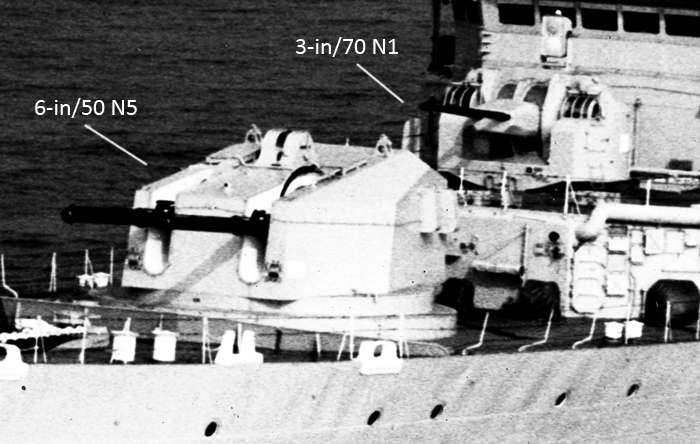
That was the most contentious point. Instead of the semi-automated triple gun turrets of the Swisftsure/Superb, the Tiger class (some authors says sub-class) it was decided after the long genesis and debates seen above, that they would adopt brand new twin, fully automated turrets, radar guided for AA fire. They were completmented were equally new 3 inches/70 Mark twin turrets for AA fire. No Bofors were retained as judged too inneficient and close range. This made for a total of just ten guns, a far cry of the Town class of old in appearance. On paper they fired several fold faster and with greater range, traverse, elevation and accuracy that anything made before. But they lacked anti-ship capabilities, having a limited main firepower (it was even down to just two main guns, two secondaries after the helicopter conversion) and no torpedo tubes. The problem was the main guns were considered “a disaster” and never met expectations.
6-inches/50 Mk.N5, Mark 26 turret
The development of what was called the “Mark V gun” started in 1942 and called at the time for triple Mark 25 mountings for the planned Neptune-class cruisers, later cancelled in 1946. It was redesigned as a twin, fully automated mount Mark 26, fully dual purpose. It was tailored for rapid automatic fire, radar assisted with fused shells on the planned Minotaur-class cruiser.They were a return also to brass cartridges but the automation and fast reload at any angle was a daunting prospect. Two experimental cannned were completed and tried in 1949, and after the Minotaur-class were cancelled, they were now assigned to the new Tiger class cruisers under the N5 mark, former Mark V, with the Mark 26 mounting. The Tiger hulls had been indeed widened to cope with the new turret’s larger rings and AC current with a completely new electric network. Initial trials were done at Shoeburyness range (Essex) and the first complete mount with turret was installed on the old County-class cruiser HMS Cumberland, converted as trial ship in 1949–1951, installed on her B superfiring mount forward. She also tested on the “X” position aft upper position the twin Vickers QF 3-inch Mark N1 also intended for the Tiger-class. In April 1957, Cumberland had firing trials and sent some 645 6-inch rounds in a course of it, revealing grave issues.
The guns were highly dependent on the Gun Direction System (GDS1) and Type 992 radar for accuracy and speed. Two twin 6-inch mounts, fore and one aft were planned for the Tigers, and with the three twin 3-inch guns it was expected of them on paper a 800 shells per minute barrage. This was still true to the 3-inches, but not the 6-inches.
They entered service as HMS Tiger was commissioned in 1959 but gained rapidly a reputation for unreliability and difficult maintenance wirth few technicians available to keep them operational. The earlier hydraulically actuated mountings were so cursed that this was later swapped for electrical operation. Useless as conventional ship, HMS Blake in 1969 and HMS Tiger in 1972 were converted as helicopter cruisers, eliminating their aft turret. They fired the last British 6-inches rounds ever by December 1979 in the English Channel.
⚙ specifications Mark N5 6-inch (152 mm) |
|
| Weight | 15,344 lb (6.960 t) |
| Barrel length | 315 in (8 m) oa, Barrel 300 in (7.62 m) 50 calibres |
| Elevation/Traverse | -5 to +78.5 degrees, 300° |
| Loading system | Automated hydraulic, horizontally sliding breech block |
| Muzzle velocity | 2,520 ft/s (770 m/s) |
| Range | 25,000 yd (23,000 m) at 45° elevation (firing AP shot) |
| Guidance | Radar, GDS1 FCS, Type 992. |
| Mount | Modified Mark XXVI (Mark 26) |
| Crew | |
| Shell | AP 129.75 lb (58.85 kg), HE 132 lb (60 kg) |
| Rate of Fire | 15 to 20 rounds per minute (30 rpm initially planned) |
3-inches/70 Mark 6

British version of the US built 3″/50 caliber AA (anti-aircraft) artillery Mark 23 and later 24. The mounting for the guns was built by Vickers as the twin 3-inch/70 Mark 6, three installed in a ltriangle position on the British Tiger-class cruisers with three mountings, one forward, two amidships either beam. They also equipped the Canadian Restigouche-class and Mackenzie-class destroyer escorts and could elevate to 90° at 30° per second and train at 60° per second.
Seacat SAM (Post 1964 conversion)
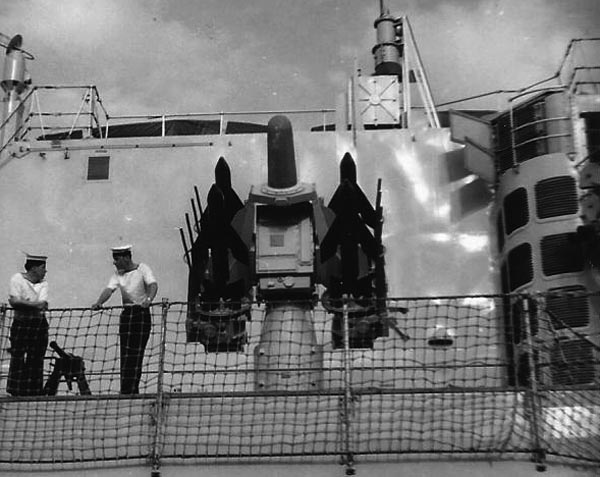
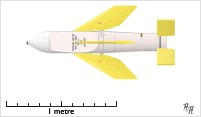 The need to fit a hangar eliminated the aft main gun mount and the 3-in/70 N1 were seen at that stage hopeless against fast jets and missiles, so it was decided to replaced the two amidship mounts with quad Seacat systems in their former location, with plenty of space and a good arc of fire, which was also capable of cross-deck fire to an extent, so a potentially 8-missile launch at any moment. Still, they were short range, low power weapons unable to deal with Soviet bombers but more useful against slow Soviet 1st gen. cruise missiles which had the size of jets.
The need to fit a hangar eliminated the aft main gun mount and the 3-in/70 N1 were seen at that stage hopeless against fast jets and missiles, so it was decided to replaced the two amidship mounts with quad Seacat systems in their former location, with plenty of space and a good arc of fire, which was also capable of cross-deck fire to an extent, so a potentially 8-missile launch at any moment. Still, they were short range, low power weapons unable to deal with Soviet bombers but more useful against slow Soviet 1st gen. cruise missiles which had the size of jets.
Seacat Mark 1:
Dimensions 1.48 x 0.22 m (58 x 8.7 in)
Weight 68 kg (150 Ib)
Propulsion 2 stage motor
Top speed Mach 0.8
Range/Ceiling 500-1,000 m (1,600-16,400 ft)
Warhead 18 ks (40 lb) continuous rods warhead, fuse.
Guidance CLOS, radio link

Sensors 1958
Type 965 air-surveillance radar with outfit AKE(1) aerial
Type 992Q: target-indication radar
Type 903 (two): gunfire-control radars (MRS 3 system)
Post refit sensors:
Type 277Q/278 Height-finding radar halfway up the mainmast similar to the Type 277Q but easier to maintain.
Type 965M: Air warning radar with an AKE-1 single bedstead aerial at the top of the mainmast, narrower beam for air direction
Type 992Q: Surface search radar at the top of the foremast with a range of 30 nautical miles (56 km)
Type 903 (five posts) FC gunnery radar, later Type 904
The were four MRS 3 fire control directors (one for each turret and Seacat mounting) each fitted with a Type 903.
Type 904 (two): Seacat fire-control radars (GWS 22 system)
Air Group (Post 1964 conversion)
Westland Wessex

The Westland Wessex was a British-built turbine-powered helicopter as a license-built Sikorsky S-58 with a turboshaft engine significantly improving its performance.
Thus was a single or twin Rolls-Royce Gnome turboshaft engines depending on the variant. It was primarily used for anti-submarine warfare (ASW) but troop transport, and search and rescue (SAR) with varied external loads and had a large cabin for personnel or equipment.
The ones sported by the Tiger class as converted were likely the Wessex HAS.3 anti-submarine variant for escort and Wessex HC.2 when acting in amphibious warfare.
The Wessex was used extensively by the Royal Navy until 1980s, including the Falklands War and one of the first helicopters to rely entirely on turbine engines and was known for its robustness and reliability in various environments, including harsh maritime conditions.
Westland Sea King
The Westland Sea King is the licenced versiosn of the Sikorsky S-61 Sea King, significantly modified and adapted to meet the specific requirements of the British Armed Forces, notably the RN. It is powered by two Rolls-Royce Gnome turboshaft engines, kept the original an amphibious hull to land on water, and had a five-bladed main rotor. The model sported by the Tiger class was likely the Sea King HAS.1 initial anti-submarine warfare (ASW) variant, equipped with sonar, radar, and torpedoes. It was replaced in the 2000s by the new EH.101.
⚙ specifications 1958 |
|
| Displacement | 9,500t standard, 11,700 tons FL |
| Dimensions | 555.5 x 64 x 23 ft (169.3 x 20 x 7 m) |
| Propulsion | 4 shaft Parsons steam turbines, 4 Admiralty-type three drum boilers 80,000 shp (60 MW) |
| Speed | 31.5 knots (58.3 km/h; 36.2 mph) |
| Range | 8,000 nmi (15,000 km; 9,200 mi) at 16 knots (30 km/h; 18 mph) |
| Armament | 2×2 QF 6-in Mark N5 DP, 3×2 QF 3-in Mark N1 AA |
| Protection | Belt 3.5 in, Bulkheads 2 in, Turrets 2 in Crowns/mags 2 in |
| Sensors | Type 965+ AKE(1) aerial, Type 992Q TIR, 2 × Type 903 GFCS MRS 3 system |
| Air Group | |
| Crew | 712-722 |
1960s Modernization
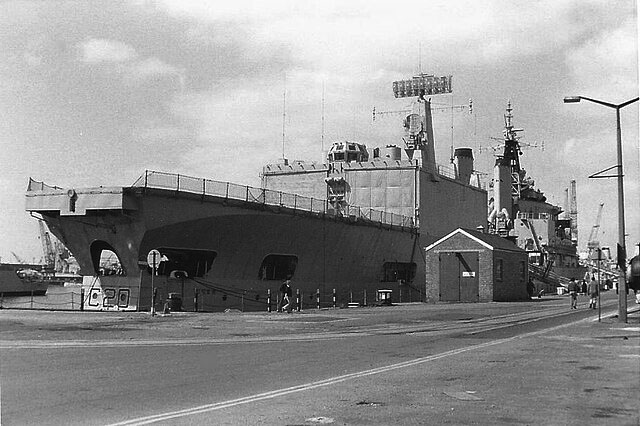
In fact in the end, it was estimated that her new twin Mk 26 6-inch automatic guns were woefully unready. Operators complained they jammed constantly and could practically never filled their basic requirement of a continuous 30 second burst. HMNZS Royalist (a former Bellona class, completely modernized) was reactivated to escort carriers in Southeast Asia by 1964 and potentially meet the Sverdlov class KRI Irian recently acquired by Indonesia. She also supported amphibious carriers with air defence but by 1966 just like Blake and Lion she was retired from the Indonesia-Malaya confrontation. Darings were refitted with MRS3 fire-control and acted as substitute for the Tigers, as another nail in their coffins.
By 1964 the new Conservative Government and even most in the naval staff saw the Tigers as costly and no lo,ger useful as surface combatanys or even escorts. The admiralty still saw them just being completed and having no more than three years or service on average at immense expense. On the taxpayer point of view it was a minefield to have theml just scrapped, and placing them in reserve could still cost some more.

Still financial pressures in the RN, notably with the development of the very advanced, nuclear powered, large CVA-01 aircraft carriers and their missile destroyer or escort cruiser programme armed with Sea Dart and Ikara systems were also a cistly endeavour. Eventually the first choice (the destroyers ended HMS Bristol as a one-off as CV01 was cancelled) of hybrid missile and helicoper cruisers operating four Chinook helicopters and accommodation for 700 troops had traction, until cancellation, as well as the last four of the ten planned County-class guided missile destroyers.

Attention returned to the Tigers in operational reserve and some proposed better conventional cruisers to replace them in 1960 or even modified County-class destoryers without Seaslug and a hangar for 4-6 Wessex helicopters or the RAN proposal of an enlarged County design to cruiser standards (additional workshops, stores, good armour protection) for three Wessex and Tartar missile. Yet the cost of it was compare to the first British nuclear missile submarines. The Escort cruisers proposal was postponed and later buried as Vickers design teams and naval architects all committed on HMS Dreadnought, the first British SSN. In 1963 it was argued that the conversion of the Tigers was identified as the quickest and cheapest solution. It was decided on a stroke to have a hangar installed aft, with four Westland Wessex helicopters capable of carrying Royal marine Commando and ASW work “East of Suez”. The conversion design was eventually approved on 24 January 1964.
As converted, the “Y” of just aft main gun turret was removed entirely, with the turret ring and the wole area was plated over. Instead, a large hangar was built as well as a large heliceck one level above the stern section. For their new amphibious assault role it was believed keeping the forward turret, now that many issues had been fixed would be ideal to deal with shore target as rate of fire was less important. In 1964 indeed, the N5 was operative without a hitch at 15 rpm, quite sufficient for suppression of fixed targets. They seemed ideal with their good range, internal space for operations “east of Suez” given Britain’s logistical issues to maintain at least one operational carrier and one commando carrier at that stage. The original plan was to retain all three twin 3-inch mounts, with an updated sonar, and a radar including the Type 965, replacing the Type 992 target indicator radar, with the Type 993. The British Army in 1964 found this compromise ideal in the frame of the Indonesian confrontation.
There were still discussions and three configurations, called schemes X, Y, and Z were drafted and reviewed in 1965 for conversion:
X Scheme: Deck space for one helicopter, hangar for three, no aft 6-in turret, no maintenance space
Y Scheme: Deck space for two Wessex, one landing/taking off at a time and hangar, no 6-in, no 3-in aft
Z Scheme: Same deck space and hangar as Y but 2 helicopters could take off/land) at once, no 6-inch/3-in.
Z looked the more promising of effective operations and was chosen as best option, even when compared to a projected six-year lifespan.
Soon the report stated to the MoD a 15 months time conversion at a cost a £2 million per ship which seemed reasonable at the time. Work was to take place at the same time as a refit to not disturbed current operational assignations, but the final cost ballooned for £12 million for all three, so about twice as much as anticipated, to which were added £10.5 million for the four Wesex helicopters. The FAA was however 37 pilots short on 75 planned.
The new Labour Government elected in October 1964 could have the conversion cancelled and the ship scrapped but it was decided to justify the conversion as retaining these large ships, now the last British operational cruisers, for command and flagship roles. To push their case, the admiralty also argued they could play the role of anti-submarine warfare in NATO replacing costly aircraft carriers. Operations east of Suez were perfect for these ships as converted, having to deal with early diesel-electic Whiskey type Indonesian submarines. It was even discussed to have these crisers carrying nuclear depth charges.
So the the conversion of Tiger and Blake was confirmed when it was announced to phase-out of carriers in 1968. For Blake, the conversion was changed to allow to operate four more capable Westland Sea King helicopters, albeit only three could actually ever be accommodated and serviced, but the new longer hangar forced the replacement of the side 3-inch gun mounts, replaced by Seacat SAMs seen as a setp back. This conversion was also justified wit the lower priority given to ASW warfare in the Atlantic, and early development of the Invincible-class aircraft carriers. At that stage Hermes and Bulwark could still offer more hangar capacity. But for ASW with the coming up new generation of Soviet SSNs, frigates were preferred as quieter listening platforms than the Tigers, only viable as they were in the context of the far east.

As planned, conversion of Blake to a helicopter cruiser started in 1965 and Tiger in 1968. Still the structural modernisation proved more difficult and expensive as planned. Nevertheless for the few years they served, they proved efficient helicopter command cruisers and experience led to the design of the the Invincible-class as “through deck cruisers”. Lion’s conversion was cancelled however with delays and workload. However it was estimated in 1969 that Blake’s conversion was unsatisfactory. Lion was placed in reserve by late 1965 and cannibalized to complete Tiger. Tiger and Blake ended 380 tons heavier than in their original design, displacing 12,080 tons and costly to operate with a full crew, now augmented by the air crew, pilots, mechanics and officers, plus extra staff as command ships, amounted as 885. Blake’s conversion ended at £5.5 million, Tiger’s costed as much £13.25 million with inflation. It was still a lot for a more few years of service. Their retirement in 1982-86 became obvvious as their hull was built in WW2 and skilled specialists were rarer to manage their now old steam powerplant at the age of combined gas turbines.

Blake in 1969 as converted
⚙ specifications 1964 conversion |
|
| Displacement | 10,500t standard, 12,080 tons FL |
| Armament | 1×2 QF 6-in Mark N5 DP, 1×2 QF 3-in Mark N1 AA, 2× quad SeaCat SAM |
| Sensors | same plus 2× Type 904 Seacat fire-control radars (GWS 22 system) |
| Air Group | 4× Westland Wessex, later 4× Westland Sea King helicopters |
| Crew | 885 |

Career of the Tiger class

Blake was back in service post conversion in 1969 and Tiger in 1972 but lion was used for spares until sold in 1975. Cutbacks in funding and manpower and probably subistution by the Hawker Siddeley Nimrod maritime patrol aircraft and SSNs made these large surface combatants redundant for ASW with high maintenance costs. The recommissioning of HMS Bulwark and conversion of Hermes into a helicopter carrier operating Sea Kings further exacerbated the lack or usefulness for these cruisers. When reported, the shore bombardment and command capabilities were underline to justify their service. In April 1978, Tiger was discarded, Blake in 1979 and they ended laid up in reserve at Chatham Dockyard. Blake was decommissioned in 1979, the last cruiser of the Royal Navy but she fired her guns as a symbolic farewell of the cruiser arm on 6 December 1979, in the English Channel, seen by thousands of WW2 cruiser vets. In between HMS Belfast, the last of the Town class, had been preserved, but was not firing capable.

During the Falklands War, it was considered to reactivate Blake and Tiger. A team came aboard for a survey. They determined both were in good condition and recommended the reactivation favourably. They were dry-docked, HMS Blake at Chatham, Tiger at Portsmouth but by mid-May 1982, as operations went on it was estimated they would not be completed in time to take part and they returned to the mothballs. The government still had the prospect of selling them. Chile in fact showed interest but the sale negociations ultimately petered out. Eventually HMS Blake was sold forby late August 1982, Tiger by September 1986. They were probably the least beloved cruisers in Britain’s arsenal, perhaps with the Dido class.
 Tiger (ex-Bellerophon, C20)
Tiger (ex-Bellerophon, C20)

HMS Tiger ca1965
C20 or Tiger, ex-Bellerophon was initially built at John Brown and Co Ltd, on Clydebank, laid down on 1 October 1941 but only launched by 25 October 1945 and then completed for £12,820,000 by March 1959, quite a stretch. She was decommissioned on 20 April 1978. She started her career under Captain R. E. Washbourn (trials, shakedown fixes, weapons qualifications), and started operations under Captain R. Hutchins in Nothern Europe, showing the flag at Gdynia, Stockholm, Kiel and Antwerp. By late 1959 she was redeployed to the Mediterranean as flagship, Mediterranean Fleet. By late 1960, her capricious main armament led to a planned refit in 1960. She was visited Lord Carrington, First Lord of the Admiralty with his Naval Secretary (Rear-Admiral Frank Twiss) and made a gunnery demonstration.
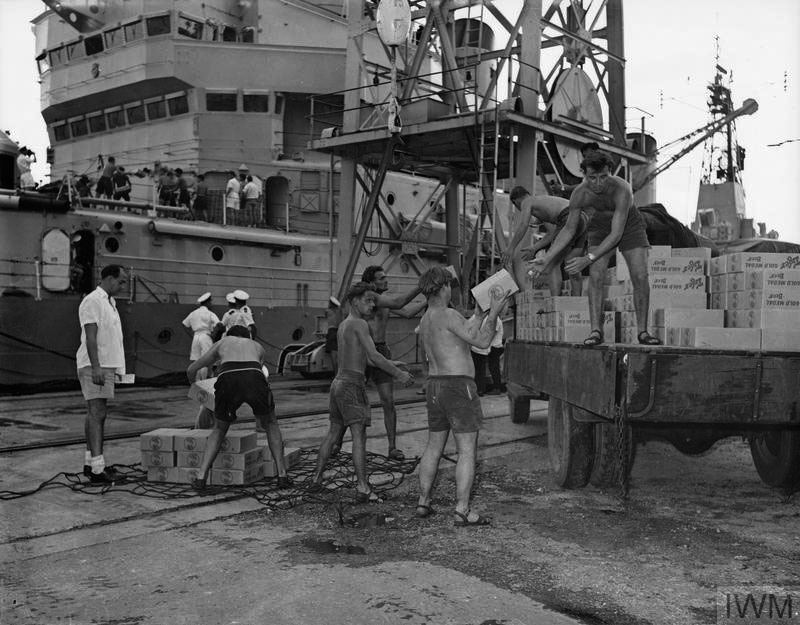
Tiger offloading stores at Brunei
She was soon reassigned to the Far East for the Indonesian Confrontation but lacked technical personnel to properly operate all her systems. By September 1963, the Glasgow Herald title she was virtually “a floating office.” Harold Wilson elected in 1964 that state of affairs. Rear-Admiral Michael Pollock served onbard from 1965 to 1966. On 10 August 1966 she had one gun accidentally firing a practice shell into Devonport Dockyard while under tests with one crewmember slightly grazed. By October 1966, she visisted Cardiff after the Aberfan disaster, assisting in rescue.
From 2 to 4 December 1966 she acted as neutral ground for discissions between PM Harold Wilson and Ian Smith of Rhodesia after the unilateral independence declaration from Britain. She was modified in Gibraltar to house both delegations. She was posted a few miles off the Rhodesian shore with the delegation ferried by boat. Tiger then moved further out to sea, and then returned to the harbour wheh it was concluded.
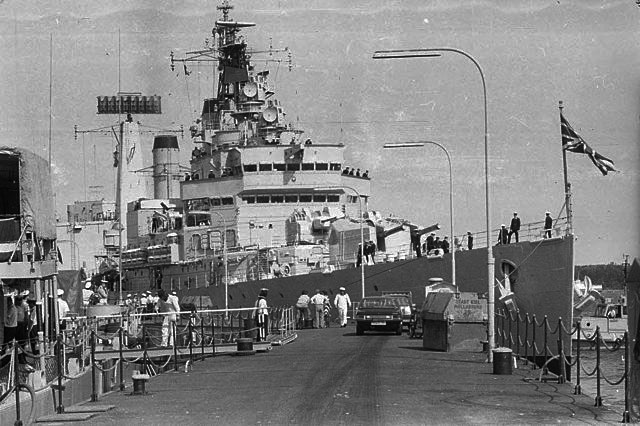
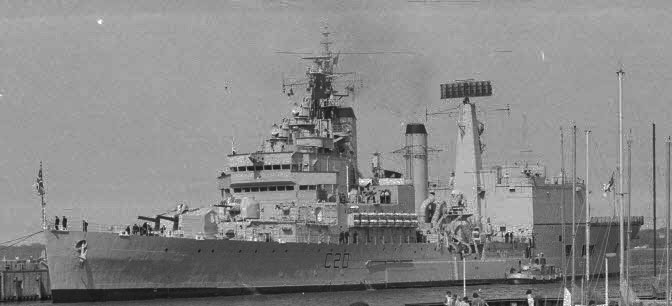
At the Kiel week 1975
HMS Tiger ended in reserve by 18 December 1966. Conversion started in 1968–72 in HMNB Devonport and she was noted for her excellent command, control, and communications facilities to even perform better her flagship tasks. She was recommissioned on 6 May 1972 but she was even more expensive to operate and maintain. Manpower shortages went on and she never was fully operational. She took part in the 1977 Silver Jubilee Fleet Review for Queen Elizabeth II but was de-activated at Portsmouth Navy Days in 1980.
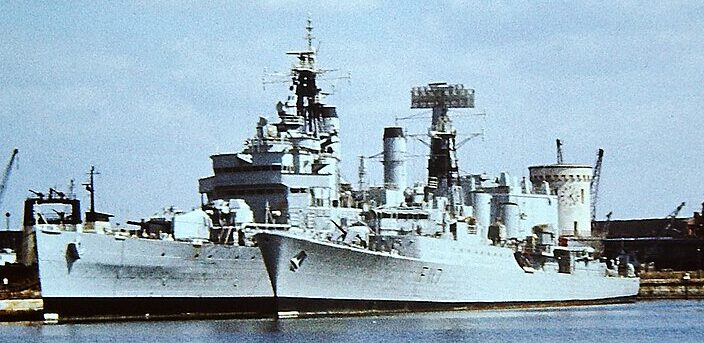
Tiger and Ashanti at Portsmouth, 1970s
She was decommissioned on 4 May 1979, placed on the disposal list but still as part of the Standby Squadron at HMNB Chatham. Reactivation for the Falklands War went to drydocking at Portsmouth for recommissioning but as the war progressed, refits were stopped.
It was also considered the UK could not afford its own Belgrano disaster, so putting them at range of Argentinian submarines was not an option.
Chile showed a faint interest in acquiring Tiger but discussions ended soon. Tiger slowly deteriorating condition until mid-1986 forced her to be sold to a Spanish breaker, from October 1986.
 Lion (ex-Defence) (C34)
Lion (ex-Defence) (C34)

C34 (HMS Lion, ex-Defence) was laid down at Scotts Shipbuilding & Engineering Co Ltd, Greenock on 24 June 1942 and up the to launching stage then completed at Swan Hunter & Wigham Richardson Wallsend-on-Tyne on 2 September 1944, but suspended and rebuilt, re-completed on 20 July 1960 for £14,375,000. She was decommissioned in December 1972.
She was rushed into service with shortcuts under political pressure and trials were stopped after severe turbine vibration issues and other problems, so she was in Plymouth for three months and really operational from February 1961. She first made a Mediterranean cruise over 20,500 miles and after Gibraltar, sailed to the South American cost and back home 1962.
On 31 July 1962 and sailed to the Mediterranean until late November and sailed to the Far East in March 1963, arrived for the Malaya independence celebrations. She visited Australia before and back home via Suez. In early 1964 she took part in the major NATO exercis, visited Spain and Portugal.
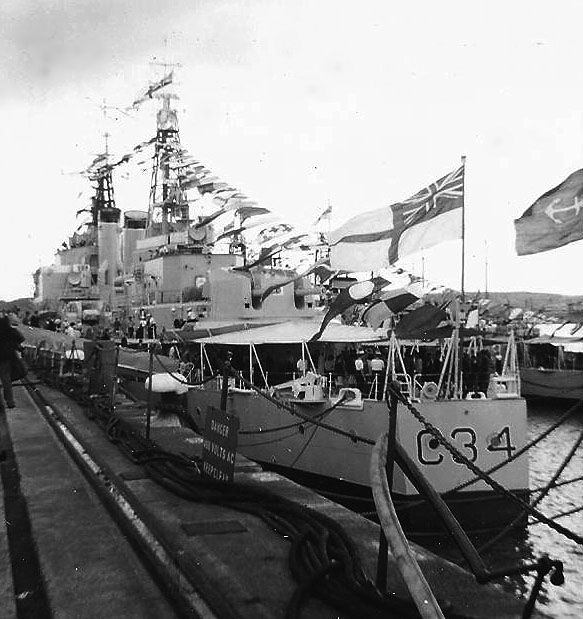
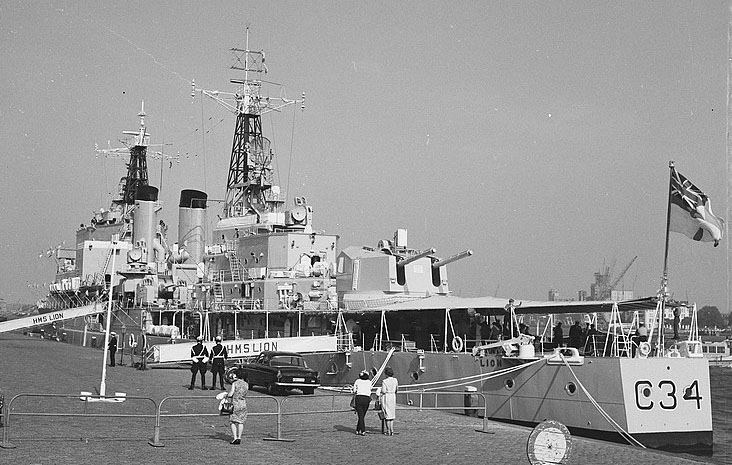
Lion at Rotterdam, 1960s
In September 1964 she was at the Maltese independence celebrations. She had a collision with the frigate Lowestoft but was repaired in Rosyth. In 1965 she was at the Gambian independence ceremony. Dhe became later flagship of a small flotilla for a visit too Sweden and at Portsmouth Navy Days in August 1965, then decommissioned, reserve at Devonport until 1972, placed on disposal list, not converted and by 15 May 1973, she was stipped out at Rosyth for parts and sold for BU on 12 February 1975, starting on 24 April 1975 at Inverkeithing. Some parts ended on an ex-Fiji class ship with Peru.
 Blake (ex-Tiger, ex-Blake) (C99)
Blake (ex-Tiger, ex-Blake) (C99)

HMS Blake after reconstruction, Key West 1979
C99 Blake (ex-Tiger, ex-Blake) was ordered to Fairfield Shipbuilding and Engineering Company Govan, Glasgow and laid down on 17 August 1942, but only launched on 20 December 1945, suspended, mothballed, then completed by 8 March 1961 at a cost of £14,940,000. She was decommissioned on December 1979. Soon after commission she saw two years of limited test, trials and training before being placed in reserve. She was converted from 1965 to 1969 as helicopter/command cruiser but while on going she had a major fire and considerable damage, raising costs and delaying completion.
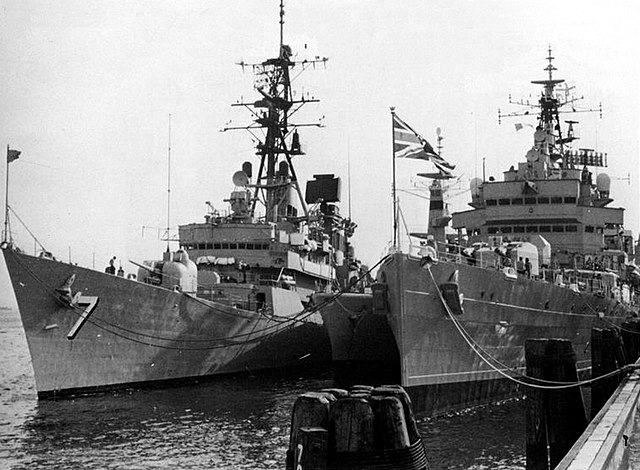
HMS Blake and USS Henry B. Wilson DDG-7 moored at Manila March 1975.
In 1969 Blake sailed to Gibraltar to show the flag after renewed Spanish hostility and blockade by General Franco. For tests, she had a Harrier jet landing on her helipad. In 1971 she took part in the ceremonial withdrawal from Malta, escorting HMS Bulwark. In 1977 she was at the Fleet Review, Silver Jubilee celebrations for the Queen off Spithead. She deployed Wessex HAS.3 helicopters of 820 Naval Air Squadron from June 1969, then Sea King HAS.1 from December 1972, until decommissioned in 1979, firing the last six-inch gun shots ever. She was refitted in 1980, and entered the Standby Squadron, HMNB Chatham. She was reactivated for the Falklands War until cancelled. Chile discussed her acquisition by June–July and she was sold for scrap on 25 August 1982 to a Queenborough company, very last British cruiser, sold August 1982, towed for the scrapyard on 29 October 1982 at Cairnryan, Stranraer, Scotland starting on November 1982. Her bell was preserved, now in Saint Mary’s Church in Bridgwater and then the Blake Museum.
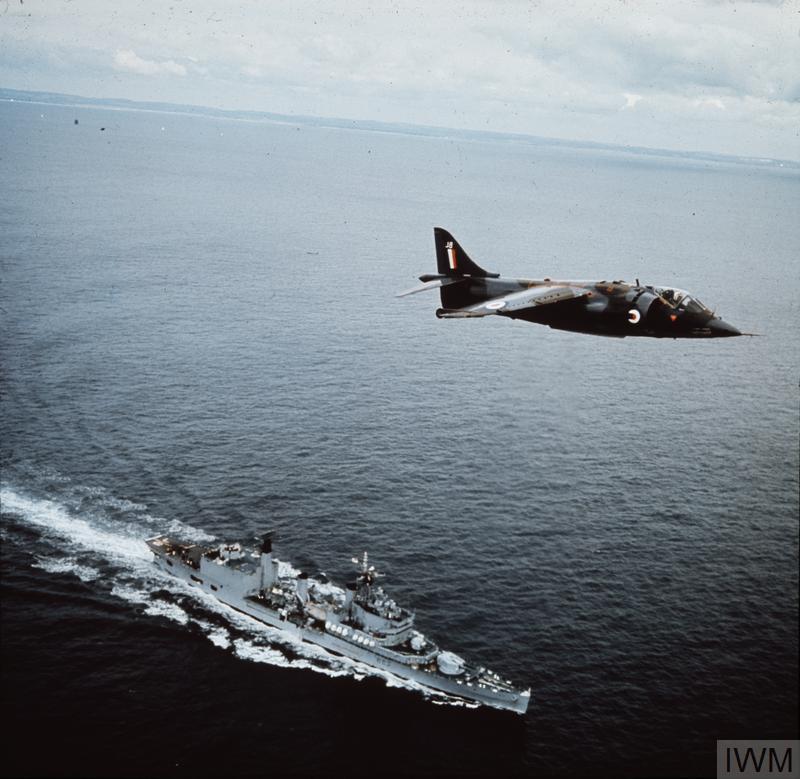
Read More/Src
Books
Conway’s all the world’s fighting ships 1947-95
British Fiji Class Cruisers and their Derivatives By Conrad Waters
Links
http://www.hazegray.org/navhist/rn/cruisers/tiger/
https://uboat.net/allies/warships/class.html?ID=186
https://www.secretprojects.co.uk/threads/the-minotaur-and-tiger-classes.39149/
https://www.navalanalyses.com/2016/08/warships-of-past-tiger-class-cruisers.html
navypedia.org
en.wikipedia.org/
https://www.worldnavalships.com/swiftsure_tiger.htm
https://laststandonzombieisland.com/tag/tiger-class-cruiser/
https://www.iwm.org.uk/collections/item/object/205164322
Videos
Model Kits
scalemates.com/ Airfix hms tiger and hms daring

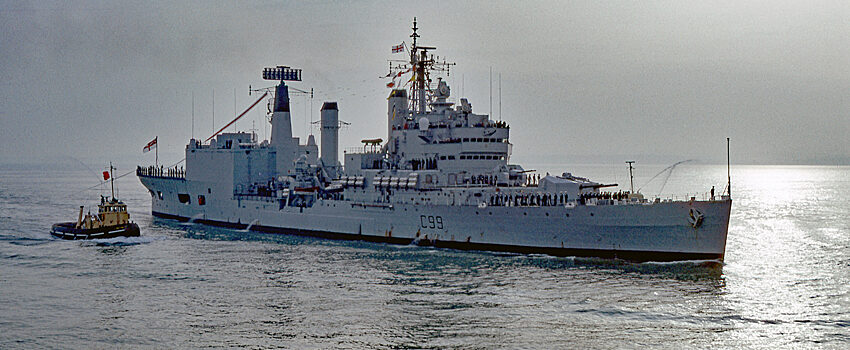

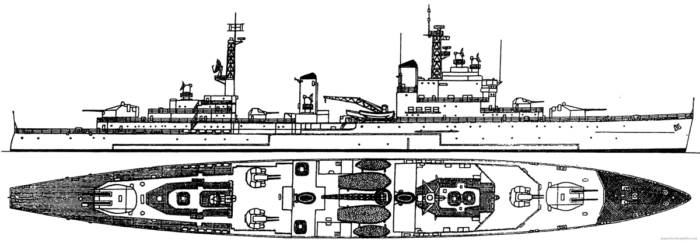
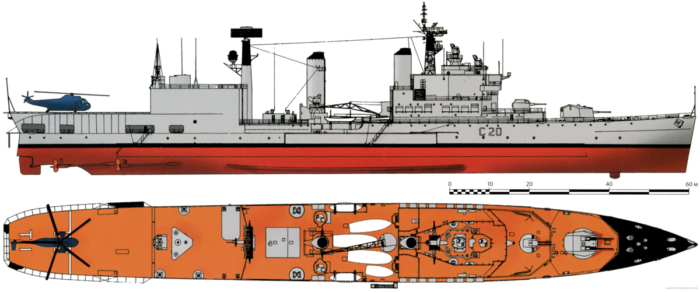
 Latest Facebook Entry -
Latest Facebook Entry -  X(Tweeter) Naval Encyclopedia's deck archive
X(Tweeter) Naval Encyclopedia's deck archive Instagram (@navalencyc)
Instagram (@navalencyc)





 French Navy
French Navy Royal Navy
Royal Navy Russian Navy
Russian Navy Armada Espanola
Armada Espanola Austrian Navy
Austrian Navy K.u.K. Kriegsmarine
K.u.K. Kriegsmarine Dansk Marine
Dansk Marine Nautiko Hellenon
Nautiko Hellenon Koninklije Marine 1870
Koninklije Marine 1870 Marinha do Brasil
Marinha do Brasil Osmanlı Donanması
Osmanlı Donanması Marina Do Peru
Marina Do Peru Marinha do Portugal
Marinha do Portugal Regia Marina 1870
Regia Marina 1870 Nihhon Kaigun 1870
Nihhon Kaigun 1870 Preußische Marine 1870
Preußische Marine 1870 Russkiy Flot 1870
Russkiy Flot 1870 Svenska marinen
Svenska marinen Søværnet
Søværnet Union Navy
Union Navy Confederate Navy
Confederate Navy Armada de Argentina
Armada de Argentina Imperial Chinese Navy
Imperial Chinese Navy Marinha do Portugal
Marinha do Portugal Mexico
Mexico Kaiserliche Marine
Kaiserliche Marine 1898 US Navy
1898 US Navy Sovietskiy Flot
Sovietskiy Flot Royal Canadian Navy
Royal Canadian Navy Royal Australian Navy
Royal Australian Navy RNZN Fleet
RNZN Fleet Chinese Navy 1937
Chinese Navy 1937 Kriegsmarine
Kriegsmarine Chilean Navy
Chilean Navy Danish Navy
Danish Navy Finnish Navy
Finnish Navy Hellenic Navy
Hellenic Navy Polish Navy
Polish Navy Romanian Navy
Romanian Navy Turkish Navy
Turkish Navy Royal Yugoslav Navy
Royal Yugoslav Navy Royal Thai Navy
Royal Thai Navy Minor Navies
Minor Navies Albania
Albania Austria
Austria Belgium
Belgium Columbia
Columbia Costa Rica
Costa Rica Cuba
Cuba Czechoslovakia
Czechoslovakia Dominican Republic
Dominican Republic Haiti
Haiti Hungary
Hungary Honduras
Honduras Estonia
Estonia Iceland
Iceland Eire
Eire Equador
Equador Iran
Iran Iraq
Iraq Latvia
Latvia Liberia
Liberia Lithuania
Lithuania Mandchukuo
Mandchukuo Morocco
Morocco Nicaragua
Nicaragua Persia
Persia San Salvador
San Salvador Sarawak
Sarawak Uruguay
Uruguay Venezuela
Venezuela Zanzibar
Zanzibar Warsaw Pact Navies
Warsaw Pact Navies Bulgaria
Bulgaria Hungary
Hungary

 Bundesmarine
Bundesmarine Dutch Navy
Dutch Navy Hellenic Navy
Hellenic Navy Marina Militare
Marina Militare Yugoslav Navy
Yugoslav Navy Chinese Navy
Chinese Navy Indian Navy
Indian Navy Indonesian Navy
Indonesian Navy JMSDF
JMSDF North Korean Navy
North Korean Navy Pakistani Navy
Pakistani Navy Philippines Navy
Philippines Navy ROKN
ROKN Rep. of Singapore Navy
Rep. of Singapore Navy Taiwanese Navy
Taiwanese Navy IDF Navy
IDF Navy Saudi Navy
Saudi Navy Royal New Zealand Navy
Royal New Zealand Navy Egyptian Navy
Egyptian Navy South African Navy
South African Navy






























 Ukrainian Navy
Ukrainian Navy dbodesign
dbodesign
Wartime design revisions:
HMS Minotaur, Swiftsure and Superb, the most advanced received indeed their nine Mk 23 turrets. In January 1943 it was decided to…?
Fixed, thx for spotting !